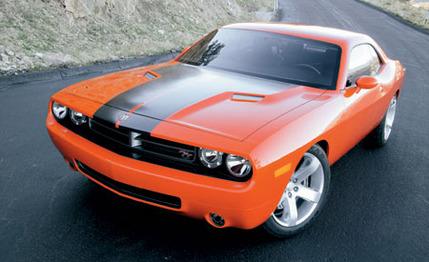 First Drive Review
First Drive Review
In the 30-plus years since a Challenger last rolled off a Dodge assembly line (the 1978-83 Dodge Challenger was a rebadged Mitsubishi), Chrysler, Dodge's parent group, has suffered some tough times. But those three decades were also peppered with major successes, and more than once Chrysler bet all its chips on a single line of cars-and won. Now that the automaker is again riding a resurgence, owing to the popularity of its LX platform (think Chrysler 300 and Dodge Magnum and Charger), perhaps the time is right for a reborn fire breather from the past to take on the popular Ford Mustang. What better time to reinvent the Hemi-powered Challenger muscle car from the '70s!
What you see here, accompanied by a wink and a nod, is the Challenger concept for the Detroit auto show. A production version seems inevitable, and unlike a couple other specials-the Viper and the Prowler-the Challenger has a good chance to sell in large numbers.
According to Tom Tremont, the vice-president of advance product creation, the inspiration for the shape of the Challenger comes from the 1970 Challenger. The original was built from 1970 through 1974, with minor changes made from year to year and about 190,000 sold in all. The designers said they chose the first Challenger as their inspiration because it is the purest and least-embellished model. Tremont's team at the Pacifica Advanced Design Center had to strip away much of the modern design idioms to which they were accustomed. For example, after a few initial sketches, the Challenger lacked a retro stance and proportions so it was decided the popular short overhangs had to go. Stretching the distance from the bumpers to the tires fixed the proportions and also canceled the LX's shortened wheelbase as the Challenger's 197.8-inch length makes it longer than a Chrysler 300 or the original Challenger. Add a blunt front end that eschews any sort of thought toward slippery aerodynamics, and it's clear the designers had to fight many of their instincts. Other touches that recall past Challengers are the wide rectangular exhaust pipes that belt out the sound of an unrestricted exhaust, the four round headlights that look like sealed-beam units but house modern lights, neon taillights that utilize technology unavailable to designers more than 30 years ago, and black hood stripes that are in fact unpainted portions of the carbon-fiber-composite hood. The large wheels are just about the only part of the concept's design that is wholly modern. Original Challengers rode on skinny tires and 15-inch wheels tucked well within the body. The concept gets five-spoke 20-inch wheels for the front fenders; larger 21-inch wheels of the same design ride behind.
To make a coupe from a sedan and wagon platform, 4.1 inches were sliced out of the LX platform's wheelbase. Production Challengers will likely be on a short-wheelbase version of the next-generation LX platform, dubbed LY. The deletion comes from the rear-seat passenger floor and reduces the wheelbase from 120.0 inches to 115.9. The LX platform's multilink independent rear suspension and strut front suspension carry over largely unchanged on the rear-drive show car. It seems doubtful the Challenger will be offered in burnout-unfriendly all-wheel drive, although such a vehicle would give WRX and Evo owners something to ponder.